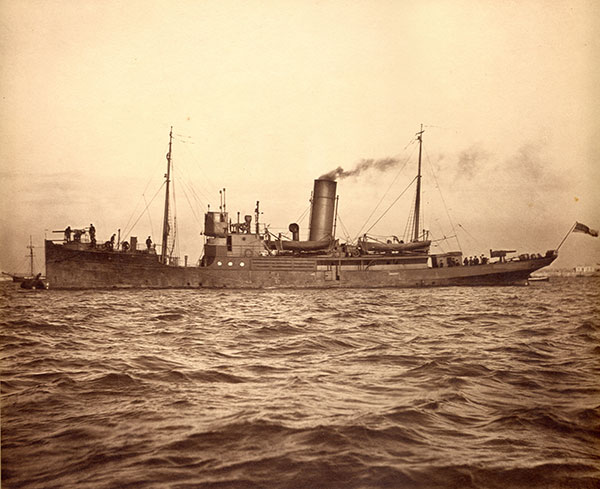1916 and the battle of the airwaves
Published in Issue 2 (March/April 2017), News, Volume 25Recent controversies about the use and misuse of electronic communications are nothing new. Not only did the 1916 Rising challenge the British Empire but it also challenged Britain’s supremacy of the airwaves.
By Eddie Bohan
The British controlled the European airwaves as the opening shots of the Great War echoed across the Continent; they cut the undersea telegraph cables that connected Europe with North America and thus hampered Germany’s communications with its agents worldwide. Deprived of the cable traffic, the Germans instead switched to the newer medium of wireless telegraphy to maintain contact with their embassies and legates in the United States, but they were unaware that the British were intercepting their communications and had broken their encryption codes.

Above: HMS Helga—its guns targeted the block of buildings at the corner of Sackville Street and Abbey Street where the rebel adio station was located. (NMI)
The battles of Mount Street Bridge, the Four Courts, Enniscorthy and Ashbourne are well documented, but the battle of the airwaves and for hearts and minds through radio propaganda less so. Patrick Pearse and Joseph Plunkett realised that they would have to circumvent the strict British rules employed under the Defence of the Realm Act to impose strict censorship during the war. On 2 August 1914 a notice appeared in the London Gazette stating that it was ‘expedient for the public service that his Majesty’s Government should have control over the transmission of messages by wireless telegraphy’.
Documents relating to the plans for the Rising seized by US authorities in the Clan na Gael offices in New York in the weeks beforehand illustrated in detail the rebels’ intentions to use radio. In Dublin, as soon as the GPO headquarters had been secured, a detachment of Volunteers was sent across Sackville Street to seize the Irish School of Wireless Telegraphy on the corner of Abbey Street. The rebels, despite constant and relentless sniper fire from the British, managed to erect an aerial and repair the disused transmitter. On Tuesday of Easter Week, they began broadcasting communiqués written by Pearse, Plunkett and James Connolly. The importance to the rebels is illustrated by Connolly’s order to the men in Reis’s Chambers: ‘the main purpose of your post is to protect our wireless station’.
The British quickly realised that the rebels were broadcasting from Sackville Street, as the broadcasts were intercepted by both the wireless operator on board HMS Adventure, moored in Kingstown Harbour, and the listening station at Caernarvon in Wales, one of the ‘Y’ stations set up by Admiral Hall of Room 40 fame. Once the British had identified the building whence the broadcasts emanated, they set about putting it off the air. Artillery in the grounds of Trinity College and the Helga on the River Liffey both targeted the block of buildings where the rebel station was housed, identifiable by the aerial high above the four-storey building.
By Wednesday evening the British had stopped the broadcasts, as the entire block was now in flames and untenable. But the damage was done and the message had been received and flashed around the world that Dublin was not just suffering ‘riots and disturbances’ as claimed by the British but was in full rebellion. The broadcasts had been monitored by an American wire service journalist, Sidney Cave, and transmitted across the Atlantic, using cable stations in France to bypass the British censor. The republic proclaimed by the rebels on Easter Monday became the first declared by wireless.
The British identified further wireless stations that might be targets for rebel forces and set about reinforcing them. The Admiralty operated a wireless station in Skerries, in north County Dublin, that was part of the ‘Y’ chain of stations located around the Irish Sea detecting the movements of German U-boats. As soon as the British had landed reinforcements in Dublin, they despatched 200 men on board HMS Dee to Skerries to head off Thomas Ashe’s rebel column.
In County Kerry British soldiers were sent to protect the Valentia wireless station, an important hub for radio traffic broadcast across the Atlantic. The rebels had already made an attempt to seize Maurice Fitzgerald’s wireless equipment at his Atlantic School in Cahirsiveen in order to contact the Aud, but the car in which the Volunteers from Dublin travelled plunged off the pier in Kilorglin and three of them were drowned. Their deaths were in vain. Even if they had set up their equipment and sent out transmissions, the Aud itself had no wireless on board.
According to the witness statement of Cumann na mBan member Aoife de Burca, a rumour circulated in Dublin during Easter Week that the Volunteers had seized the wireless station in Clifden, Co. Galway, but the rebel forces in that county had scattered when a British naval vessel in Galway Bay opened fire. The influential American magazine Wireless World described Clifden at the time as ‘the most important wireless long distance station, of supreme importance, [which] would be a potent instrument of evil in the event of its falling under the control of enemy hands’.
Eddie Bohan is the author of Rebel Radio (Kilmainham Press, 2016).
















